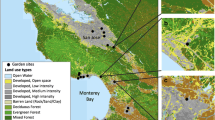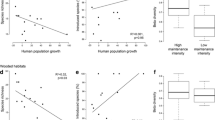Abstract
Urban vegetation is commonly described as dominated by weedy species that are adapted to human disturbance. In this study, we determined the original (pre-agriculture) habitats of urban plant species sampled quantitatively in the spontaneous vegetation of a university campus in Halifax, Nova Scotia (eastern Canada). We sampled 11 distinct patch types corresponding to different built forms. Differences in vegetation among patch types were related in part to environmental variables such as soil moisture and light availability. The urban vegetation was dominated by species from rocky habitats such as cliffs and talus slopes, with lesser representation from grassland and floodplain habitats. When compared to a null model of species origins based on the global area and species richness of different original habitats, species from rock outcrops and grassland habitats were overrepresented in the urban vegetation. These results contrast with the received view that cities represented highly “unnatural” ecosystems: built form appears to replicate the habitat templates required by rock outcrop species. Urban ecological theory should incorporate the replication of habitat analogs by built forms in addition to the creation of ecologically novel habitats.
Similar content being viewed by others
References
Alberti M, Marzluff JM, Shulenberger E, Bradley G, Ryan C, Zumbrunnen C (2003) Integrating humans into ecology: opportunities and challenges for studying urban ecosystems. BioScience 53:1169–1179
Anderson DR, Link WA, Johnson DH, Burnham KP (2001) Suggestions for presenting the results of data analyses. Journal of Wildlife Management 65:373–378
Bennet SJ (1998) The ecogeography and collection of grain, forage, and pasture legumes in south-west Turkey. Genetic Resources & Crop Evolution 45:253–262
Bishop GF, Davy AJ (1994) Hieracium pilosella L. Pilosella officinarum F. Schultz & Schultz-Bip., Journal of Ecology 82:195–210
Brodo IM, Sharnoff SD, Sharnoff S (2001) Lichens of North America. Yale University Press, New Haven, Connecticut
Clarke KR, Green RH (1988) Statistical design and analysis for a ‘biological effects’ study. Marine Ecology Progress Series 46:213–226
Clarke KR, Gorley RN (2001) PRIMER v5:User Manual/Tutorial. PRIMER-E Ltd., Plymouth, UK
Clarke KR, Warwick RM (2001) Change in Marine Communities: an Approach to Statistical Analysis and Interpretation. 2nd Edition. PRIMER-E Ltd. Plymouth, UK
Cornelius R, Faensen-Thiebes. (1990) The strategies of Solidago canadensis L. in relation to urban habitats II. Competitive ability. Acta Oecologica 11:145–153
Critchley CNR (2000) Ecological assessment of plant communities by reference to species traits and habitat preferences. Biodiversity & Conservation 9:87–105
Crowe TM (1979) Lots of weeds: insular phytogeography of vacant urban lots. Journal of Biogeography 6:169–181
Desmet P, Cowling R (2004) Using the species-area relationship to set baseline targets for conservation. Ecology and Society 9(2):11 [online] URL: http://www.ecologyandsociety.org/vol9/iss2/art11
Dow K (2000) Social dimensions of gradients in urban ecosystems. Urban Ecosystems 4:255–275
Falk JH (1979) Energetics of a suburban lawn ecosystem. Ecology 57:141–150
Freedman B, Love S, O'Neil B (1996) Tree species composition, structure, and carbon storage in stands of urban forest of varying character in Halifax, Nova Scotia. Canadian Field-Naturalist 110:675–682
Freedman B (2004) Environmental Science: A Canadian Perspective. Pearson Education Canada Inc., Toronto, Ontario
Gaston KJ, Warren PH, Thompson K, Smith RM (2005) Urban domestic gardens (IV): the extent of the resource and its associated features. Biodiversity and Conservation 14:3327–3349
Gilbert OL (1989) The Ecology of Urban Habitats. Chapman & Hall, London, UK
Gleason HA, Cronquist A (1991) Manual of Vascular Plants of Northeastern United States and Adjacent Canada. The New York Botanical Garden, New York
Grimm NB, Grove JM, Pickett ST, Redman CL (2000). Integrated approaches to long-term studies of urban ecological systems. BioScience 50:571–584
Grubb PJ (1976) A theoretical background to the conservation of ecologically distinct groups of annuals and biennials in the chalk grassland ecosystem. Biological Conservation 10:53–76
Hartnett DC (1996) Effects of bison grazing, fire, and topography on floristic diversity in tall grass prairie. Journal of Range Management 49:413–420
Hill MO (2002) Hemeroby, urbanity and ruderality: bioindicators of disturbance and human impact. Journal of Applied Ecology 39:708–720
Hope D, Gries C, Zhu W, Fagan WF, Redman CL, Grimm NB, Nelson AL, Martin C, Kinzig A (2003) Socioeconomics drive urban plant diversity. Proceedings of the National Academy of Science 100:8788–8792
Hough M (1984) City Form and Natural Process, Routledge, London, UK
Ireland R (1982) Moss Flora of the Maritime Provinces. University of Toronto Press, Toronto, Canada
Kabucis I, Rūsicņa S, Veen P (2003) Grasslands of Latvia: Status and Conservation of Semi-Natural Grasslands, European Grasslands Report No 6, Royal Dutch Society for Nature Conservation and Latvian Fund for Nature
Kier G, Mutke J, Dinerstein E, Ricketts TH, Küper, Kreft H, Barthlott W (2005) Global patterns of plant diversity and floristic knowledge. Journal of Biogeography 32:1107–1116
Kowarik I (1990) Some responses of flora and vegetation to urbanization in central Europe. In: Sukopp H, Hejny S, Kowarik I (eds) Urban Ecology. SPB Academic Publishing, The Hague, pp. 45–74
Kraus J, Klein A, Stefan-Dewenter I, Tscharntke T (2004) Effects of habitat area, isolation, and landscape diversity on plant species richness of calcareous grasslands. Biodiversity & Conservation 13:1427–1439
Kruskal JB, Wish M (1978) Multidimensional Scaling. Sage Publications, Beverly Hills, California
Kunick W (1982). Comparison of the flora of some cities of the central European lowlands. In: Bornkamm R, Lee JA, Seaward MRD (eds) Urban Ecology. Blackwell Scientific Publications, Oxford, UK, pp. 13–22
Larson DW, Matthes U, Kelly PE (2000) Cliff Ecology. Cambridge University Press, Cambridge
Larson DW, Matthes U, Kelly PE, Lundholm JT, Gerrath JA (2004) The Urban Cliff Revolution: New Findings on the Origins and Evolution of Human Habitats. Fitzhenry & Whiteside, Markham, Canada
Lundholm JT (2005) A habitat template approach to green building surfaces. conference proceedings: Green Roofs for Healthy Cities, Toronto, Canada. pp. 14
Marks PL (1983) On the origin of the field plants of the northeastern United States. The American Naturalist 122:210–228
Marlin A (2005) Microhabitat differentiation in urban plant communities. unpublished honours thesis, Saint Mary's University, Halifax, NS, Canada
May R (2004). Editorial—On the role of the humanities in urban ecology: the case of St. Petersburg. Urban Ecosystems 7:7–15
McDonnell MJ, Pickett STA, Groffman P, Bohlen P, Pouyat RV, Zipperer WC, Parmelee RW, Carreiro MM, Medley K (1997) Ecosystem processes along an urban-to-rural gradient. Urban Ecosystems 1:21–36
McKinney ML (2002) Urbanization, biodiversity, and conservation. Bioscience 52:883–890
Mintenko AS (2002) Turfgrass evaluation of native grasses for the northern Great Plains region. Crop Science 42:2018–2024
Mitlacher K, Poschlod P, Rosen E, Bakker JP (2002). Restoration of wooded meadows—a comparative analysis along a chronosequence on Oland (Sweden). Applied Vegetation Science 5:63–73
Mosseler A, Lynds JA, Major JE (2003) Old-growth forests of the Acadian Forest Region. Environmental Reviews 11:S47–S77
Muller S (1999) Plant communities and conservation of Botrychium-rich grasslands in the Bitcherland (Northern Vosges Biosphere Reserve, France) Biodiversity & Conservation 8:1519–1532
Peev D (1999) Plant Biodiversity in Rila National Park: Species and Coenotic Levels, Bulgaria GEF Biodiversity Project
Pelechaty M (1999) The phytosocological characteristics and habitat requirements of the Phragmitetum communis (Gam, 1927) Schmale, 1939 phytocoenoses in the lakes of the Wielkopolski National Park. Hydrobiologia 408:329–334
Pickett STA, Burch WR Jr., Dalton SE, Foresman TW, Grove JM, Rowntree R (1997) A conceptual framework for the study of human ecosystems in urban areas. Urban Ecosystems 1:185–199
Pickett STA, Cadenasso ML, Grove JM, Nilon CH, Pouyat RV, Zipperer WC, Costanza R (2001) Urban ecological systems: Linking terrestrial ecological, physical, and socioeconomic components of metropolitan areas. Annual Review of Ecology and Systematics 32:127–157
Quammen D (1998) Planet of weeds. Harper's Magazine, Oct.:57–69
Rebele F (1994) Urban ecology and special features of urban ecosystems. Global Ecology and Biogeography Letters 4:173–187
Rodwell JS (1992) British Plant Communities Volume 2 Grasslands and Montane Communities. Cambridge University Press, Cambridge
Rodwell JS (2000) British Plant Communities Volume 5 Maritime Communities and Vegetation of Open Habitats, Cambridge University Press, Cambridge
Saner MA, Clements DR, Hall MR, Doohan DJ, Crompton CW (1995) The biology of Canadian weeds. 105. Linaria vulgaris Mill. Canadian Journal of Plant Science 75:525–537
Schischkin BK (1999). Flora of the USSR Vol. XXV. Smithsonian Institution Libraries, Washington DC
Schischkin BK, Borov EG (1997) Flora of the USSR Vol. XXII. Smithsonian Institution Libraries, Washington DC
Schischkin BK, Borov EG (2000) Flora of the USSR Vol. XXVI. Smithsonian Institution Libraries, Washington DC
Shafigullina SM (2004) Influence of post-flood hydrologic conditions in the Kuibyshev Reservoir on coastal communities of ground beetles (Coleoptera, Carabidae). Russian Journal of Ecology 35:46–50
Silverside AJ (2004) The Wild Flowering Plants and Ferns of Wigtownshire. University of Paisley, UK
Southwood TRE (1977) Habitat, the templet for ecological strategies? Journal of Animal Ecology 46:337–365
Spirn SA (1984) The Granite Garden: Urban Nature and Human Design. Basic Books, New York
Stepp JR, Jones EC, Pavao-Zuckerman M, Casagrande D, Zarger RK (2003). Remarkable properties of human ecosystems. Conservation Ecology 7(3):11. [online] URL: http://www.consecol.org/vol7/iss3/art11
Taran GS (1994) Floodplain Ephemeretum of Middle Ob-a new class for Siberia, Isoto-Nanojuncetea Br.-Bl. Et Tx. 1943 on the northern border of expansion. Siberian Journal of Ecology 1:578–582
Taran GS (1995) A little-known vegetation class of the former USSR-flood plain Ephemeretum. Siberian Journal of Ecology 2:372–380
Tatli A (2002) The flora of upper Ceyhan Valley (Kahramanmaras/Turkey) Turkish Journal of Botany 26:259–275
Taylor DR, Aarssen LW, Loehle C (1990) On the relationship between r/K selection and environmental carrying capacity: a new habitat templet for plant life history strategies. Oikos 58:239–250
Thompson K, Austin KC, Smith RM, Warren PH, Angold PG, Gaston KJ (2003) Urban domestic gardens (I): putting small-scale plant diversity in context. Journal of Vegetation Science 14:71–78
Turner WR, Nakamura T, Dinetti M (2004) Global urbanization and the separation of humans from nature. BioScience 54:585–590
Turner K, Lefler B, Freedman B (2005) Plant communities of selected urbanized areas of Halifax, Nova Scotia, Canada. Landscape and Urban Planning 71:191–206
Tutin TG, Heywood VH, Burges NA, Moore DM, Valentine DH, Walters SM, Webb DA (1980) Flora Europea Vols. 1–5. Cambridge University Press, UK
USGS (2004) Northeast Wetland Flora Field Office Guide to Plant Species, United States Geological Survey, Northern Prairie Wildlife Research Centre
Voss E G (1985) Michigan Flora. Part II. Dicots (Saururaceae-Cornaceae). University of Michigan Herbarium, Ann Arbor
Voss EG (1996) Michigan Flora. Part III. Dicots (Pyrolaceae-Compositae). University of Michigan Herbarium, Ann Arbor
Wittig R (2004) The origin and development of the urban flora of Central Europe. Urban Ecosystems 7:323–339
Woodell S (1979) The flora of walls and pavings. In: Laurie IC (ed) Nature in Cities. John Wiley & Sons, New York, pp. 135–156
Wu Z, Raven PH, Hong D (2001) Flora of China. Science Press, Beijing; Missouri Botanical Gardens Press, St. Louis, Missouri
Zinck M (1998) Roland's Flora of Nova Scotia. Nimbus Publishing & Nova Scotia Museum, Halifax, Canada
Zobel K, Liira J (1997) A scale-independent approach to the richness vs biomass relationship in ground-layer plant communities. Oikos 80:325–332
Author information
Authors and Affiliations
Corresponding author
Rights and permissions
About this article
Cite this article
Lundholm, J.T., Marlin, A. Habitat origins and microhabitat preferences of urban plant species. Urban Ecosyst 9, 139–159 (2006). https://doi.org/10.1007/s11252-006-8587-4
Published:
Issue Date:
DOI: https://doi.org/10.1007/s11252-006-8587-4




